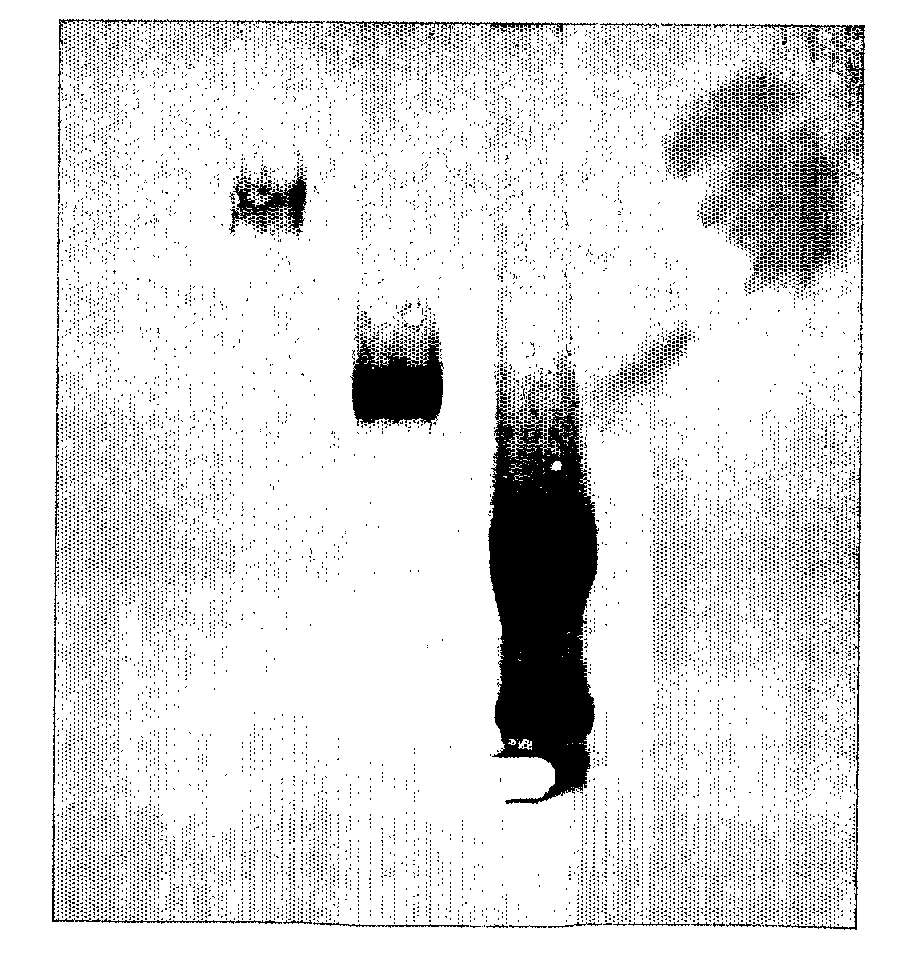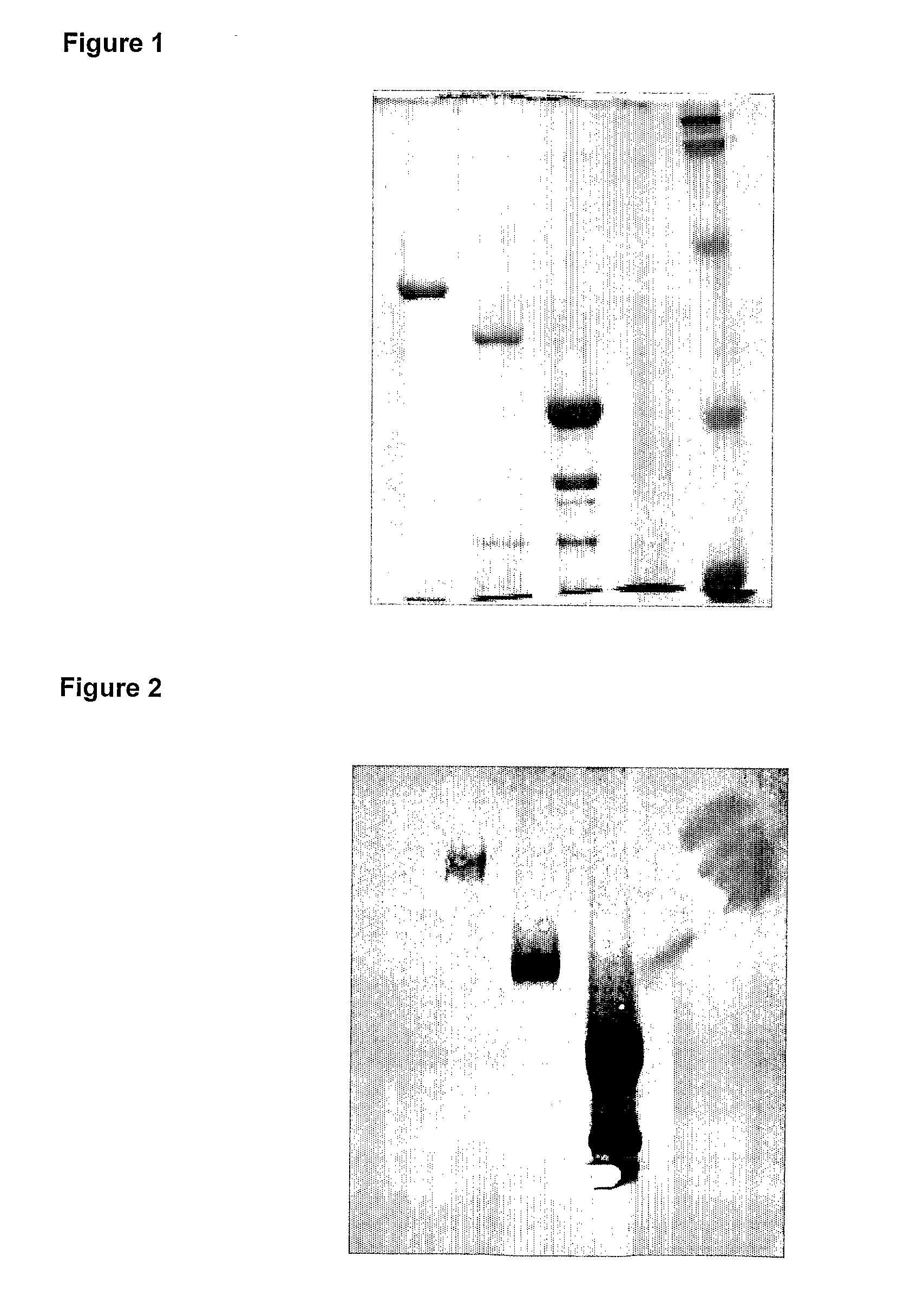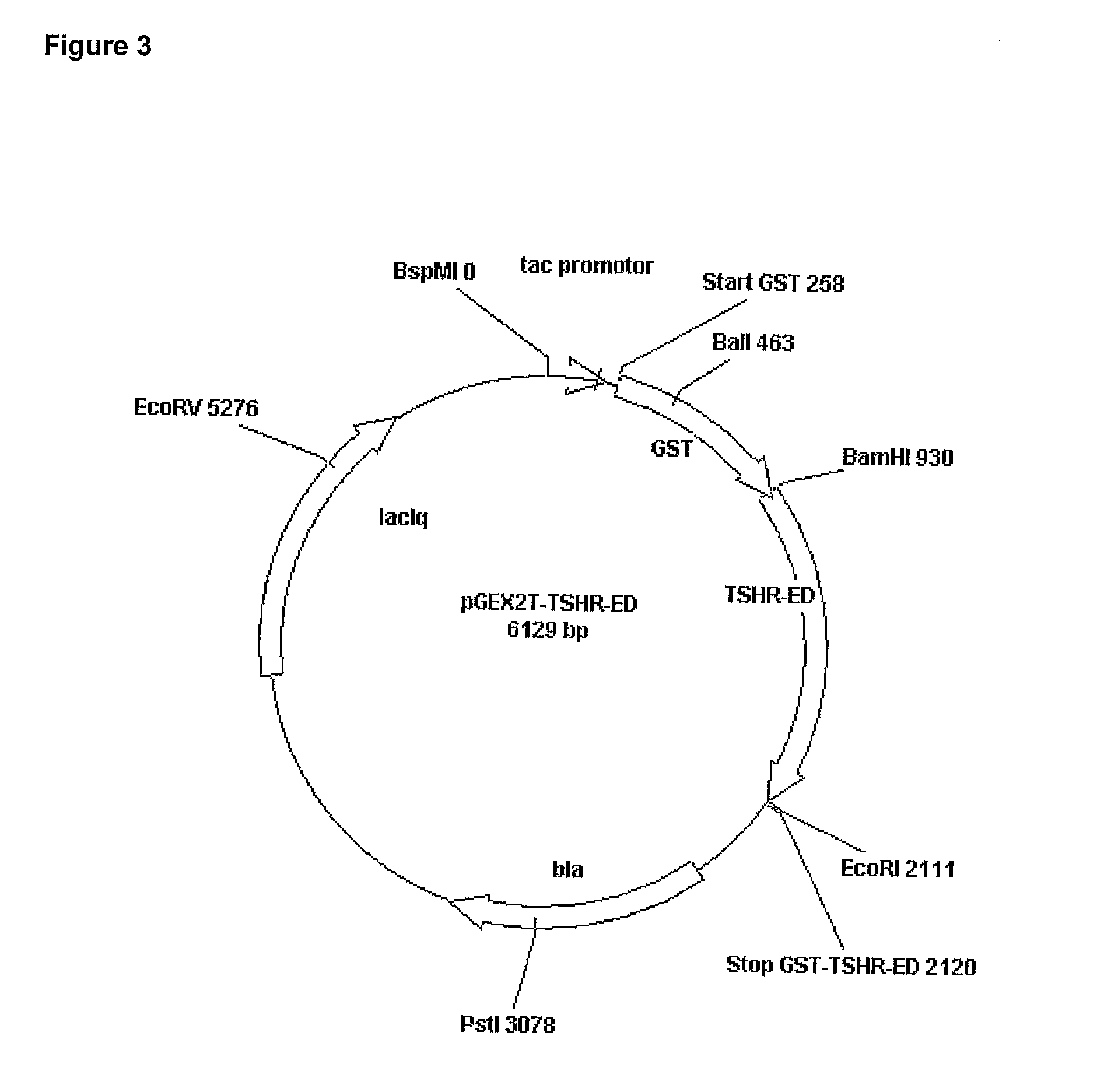Recombinant Polypeptides and Methods for Detecting and/or Quantifying Autoantibodies Against Tsh Receptor
a technology of tsh receptor and autoantibodies, which is applied in the direction of peptide/protein ingredients, transferases, bacteria, etc., can solve the problems of inability to use insect cells for the production of glycosylated human proteins, and inability to detect and quantify autoantibodies. , to achieve the effect of low cross reactivity, high binding activity and high binding specificity
- Summary
- Abstract
- Description
- Claims
- Application Information
AI Technical Summary
Benefits of technology
Problems solved by technology
Method used
Image
Examples
example 1
DNA and Peptide Sequence of the Human TSH Receptor Used to Produce TSHR-ED, TSHR-210, TSHR-310
[0128]The sequences TSHR-ED, TSHR-210, TSHR-310 refer to the human TSH receptor as available under GeneBank accession number M73747 (GI:903759). The amino acid sequence of the human Thyrotropin Receptor is as follows:
MRPADLLQLVLLLDLPRDLGGMGCSSPPCECHQEEDFRVTCKDIQRIPSLPPSTQTLKLIETHLRTIPSHAFSNLPNISRIYVSIDVTLQQLESHSFYNLSKVTHIEIRNTRNLTYIDPDALKELPLLKSLAFSNTGLKMFPDLTKVYSTDIFFILEITDNPYMTSIPVNAFQGLCNETLTLKLYNNGFTSVQGYDFFGTKLDAVYLNKNKYLTVIDKDAFGGVYSGPSLLDVSQTSVTALPSKGLEHLKELIARNSWTLKKLALSLSFLHLTRADLSYPSHCCAFKNQKKIRGILESLMCNESSIETLRQRKSVNALNSPLHQEYEENLGDSIVGYKEKSKFQDTHNNAHYYVFFEEQEDEIIGFGQELKNPQEETLQAFDSHYDYTICGDSEDMVCTPKSDEFNPGEDIMGYKFLRIVVWFVSLLALLGNVFVLLILLTSHYKLNVPRFLMCNLAFADFCMGMYLLLIASVDLYTHSEYYNHAIDWQTGPGCNTAGFFTVFASELSVYTLTVITLERWYAITFAMALDRKIRLRHACAIMVGGWVCCFLLALLPLVGISSYAKVSICLPMDTETPLALAYIVFVLTLNIVAFVIVCCCYVKIYITVRNPHNPGDKDTKIAKRMAVLIFTDFTCMAPISFYAVSAILNKPLITVSNSKILLVLFYPINSCANPFLYAIFTKAFQR...
example 2
Constructs and Cloning Procedure
[0131]The sequences of the TSHR-Variants presented (TSHR-ED, TSHR-210, TSHR-310) were directly fused to the C-Terminus of Glutathione S-Transferase (GST) from Schistosoma Japonicum using the commercially available vector pGEX-2T from Amersham Biosciences. The GST sequence refers to the GeneBank accession U13850. In the cloning procedure the TSHR-Variants were, according to the restriction sites in the PCR primers, cloned with their 5′ portion into the BamHI-site of the pGEX-2T multicloning site and with their 3′ portion into the EcoRI-site of this vector. According to this cloning procedure 6 additional amino acids (Glutamate (E) and Phenylalanine (F), Isoleucine (I), Valine (V), Threonine (T) and Aspartic acid (D) bold, green, are fused to the very C-terminal lysine (K) of the extracellular portion of the TSHR protein. Directly after this additional amino acids the reading frame is terminated via a tga STOP-Codon encoded by the vector.
TSHR-Fusion Pro...
example 3
Purification of the Recombinant GST-TSHR-Fusion Proteins
[0135]Expression and purification of the various TSHR-variants was performed according to the following experimental procedure.
a. Fresh Transformation of pGEX2T-TSHR vectors (ED, 210, 310) in the bacterial strain BL21 (typically 10 ng plasmid DNA / 200 μl competent bacteria)
b. O / n culture under selection pressure (ampicilline 100 μg / ml final concentration)
c. Dilution of the o / n culture (1 / 20) and cultivation until logarithmical growth of the culture
d. Induction of the target gene by addition of IPTG (final concentration: 1 mM).
e. Induction culture for further 4 h
f. Isolation of the bacteria by centrifugation
g. Resuspension and wash of the bacteria in Tris buffered saline (TBS: 50 mM Tris pH 8.0, 150 mM NaCl)
h. Resuspension of the bacteria in Lysis / Solubilsation buffer (TBS, 1% Triton X100, 1 mM DTT, 1 mM EDTA)
i. Disruption of the bacteria by sonification (lysate preparation)
j. Solubilization of fusion proteins by incubation / agita...
PUM
| Property | Measurement | Unit |
|---|---|---|
| apparent molecular weight | aaaaa | aaaaa |
| apparent molecular weight | aaaaa | aaaaa |
| molecular weight | aaaaa | aaaaa |
Abstract
Description
Claims
Application Information
 Login to View More
Login to View More - R&D
- Intellectual Property
- Life Sciences
- Materials
- Tech Scout
- Unparalleled Data Quality
- Higher Quality Content
- 60% Fewer Hallucinations
Browse by: Latest US Patents, China's latest patents, Technical Efficacy Thesaurus, Application Domain, Technology Topic, Popular Technical Reports.
© 2025 PatSnap. All rights reserved.Legal|Privacy policy|Modern Slavery Act Transparency Statement|Sitemap|About US| Contact US: help@patsnap.com



